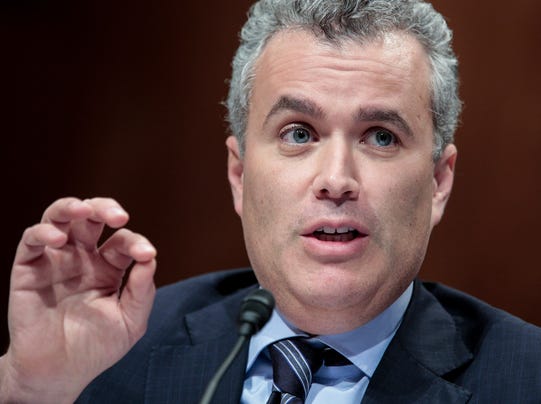
Jeffrey Zients testifies before the Senate Budget Committee on April 11.(Photo: T.J. Kirkpatrick, Getty Images)
[h=3]Story Highlights[/h]
- White House officials say user capacity has been doubled
- More than 1.8 million could sign up by year's end, Zients says
- Republicans still calling for major delays in health care law
WASHINGTON — Healthcare.gov has doubled its user capacity and eliminated many bugs in time for today's deadline, when the Obama administration pledged the problematic website would operate smoothly "for the vast majority" of people trying to access the site.
Jeffrey Zients, who is leading a technical team charged with fixing the website after its disastrous Oct. 1 rollout, said capacity is being increased to 50,000 simultaneous users and more than 800,000 total consumer visits a day.
That would allow about 1.84 million people to "comfortably" sign up for health insurance coverage through the federal exchange by Dec. 23, or in time for Jan. 1 coverage, he said at a White House briefing. Potentially more than 9.5 million people could sign up before March 31, or the end of the 2014 enrollment period.
"That said, there could be moments in the middle of the day — seems to be the peak — where capacity goes beyond that current user level, at which point there will be a customer-friendly queuing system which would notify you when to come back to the site and sort of be first in line," Zients said. In other words, people will receive an e-mail letting them know when to return to the page.
That doesn't mean everything's fixed: Technicians are still working on the back-end functions of the site, or the portion that makes sure insurers get their checks when people who will receive subsidies enroll. As of last week, 30% to 40% of that work remained to be done.
Despite improvements, Republicans are continuing to point to the site's delays and failures. Those include delays in online enrollment for the small business exchange; worries over the security of the site; and the need for the administration to release enrollment numbers, which are not scheduled until later in December. First month's enrollment in the the federal exchange fell far short of expectations, with only about 23,000 people choosing and enrolling in insurance plans.
House Majority Leader Eric Cantor took issue with the small business exchange delay, calling it a sign that the health care law's "issues run much deeper than a failing website." He again called for a one-year delay for the federal and state exchanges, as well as for the individual mandate fee people will have to pay in 2014 if they do not have insurance.
People who have been using the site for the past week or so have already seen progress, administration officials said. They've been able to move through the site quickly, compare prices and benefits and have been notified about how much their subsidies will be or if they're eligible for coverage under Medicaid. And they've been able to enroll in health insurance plans, said Julie Bataille, director of the office of communications for the Centers for Medicare and Medicaid Services.
"So the fixes that you hear us talking about, the hardware improvements that you hear us talking about, those are all designed to improve performance and functionality of the site and the user experience for the consumers that are choosing to access this information online," she said.
When the site launched Oct. 1, millions of hits from people curious about the site or eager to enroll in health insurance overwhelmed the site, causing error messages, frozen pages and "come back later" posts.
After about a month, government officials began almost-daily briefings with reporters to explain what had been done the night before. Each evening, the site came offline while technicians added servers, updated software and replaced hardware. They also changed out portions of the site deemed confusing to consumers, attempted to make it easier for those helping consumers navigate the site to find their applications, and began e-mail notification of people who had tried early on to enroll but found their applications permanently stuck.
Rather than marketing the benefits of the Affordable Care Act, the administration found itself focused entirely on fixing the website.
Steven VanRoekel, chief information officer for the federal government, said the system is extraordinarily complex because it needs to access — but not store — Social Security information, as well as criminal background records through the Department of Homeland Security, and then it needs to check income levels at the IRS.
And, he said, people need to put the Healthcare.gov situation in perspective: The website will never be "finished" because they will continue over the years to improve it. As Bill Gates' assistant at Microsoft in 2001, VanRoekel said he helped launch Windows XP.
"And here we find ourselves nearly 12 years later, Microsoft is still patching Windows XP," he said.
